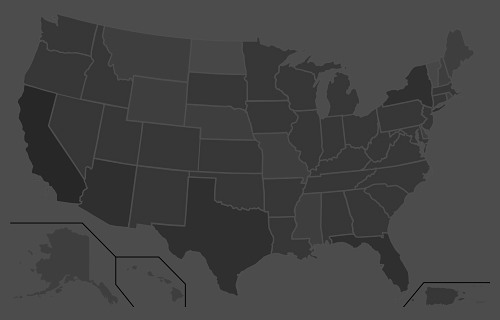“Our added winter moisture and active calling period led to a very long nesting and hatching season, starting in late April and extending into early summer, with chicks hatching as late as early July,” O’Dell said. “From a population standpoint, we are out of a deficit for the first time since 2001-2002. Quail are starting to pop up in places they haven’t been seen in a while.
“If you’ve never had the chance to experience what Arizona quail hunting built its name on, then this would be the year to get out and enjoy it.”
Meanwhile, hunters should note that the season for Mearns’ quail doesn’t begin until Dec. 4. It’s summer rainfall that plays a key role in nesting success and population numbers of this species. After a spotty and relatively weak monsoon across southern Arizona, these birds are likely to be abundant only in pockets that received sufficient precipitation this summer.
A valid Arizona hunting or combination hunt and fish license is required for all hunters 10 and older. Those hunters under 10 must either have a valid hunting or combination hunt and fish license, or be accompanied by an adult who possesses a valid hunting or combination hunt and fish license. Licenses can be purchased online or at license dealers statewide. A youth combination hunt and fish license (ages 10 to 17) is $5.
The general bag limit is 15 quail per day in the aggregate, of which no more than eight may be Mearns’ quail (when the Mearns’ season opens Dec. 4). The general possession limit is 45 quail in the aggregate after opening day, of which no more than 15 Gambel’s, scaled or California quail in the aggregate may be taken in any one day. After the opening of the Mearns’ season, the 45-quail possession limit may include 24 Mearns’ quail, of which no more than eight may be taken in any one day.
More quail-hunting information can be found on the department’s website at https://www.azgfd.com/Hunting/. Another resource for both new and experienced hunters alike is “An Introduction to Hunting Arizona’s Small Game.” Written by Randall D. Babb, the 196-page, full-color book covers where and how to hunt small game birds (like quail), squirrels, rabbits, ducks and geese. It also includes how to prepare and cook your harvest, with illustrations and recipes. The book can be ordered for $16.95 at www.azgfd.gov/publications.
Finally, hunters should check out O’Dell’s techniques for field-dressing quail at https://www.youtube.com/watch?v=3gRwZAcWzzk.
####
Publishers Notes: OUT OF STATE HUNTERS, FISHERMEN & OUTDOOR ENTHUSIASTS; Due to the Covid 19 pandemic, there could be limitations for OUT of STATE hunters, fishermen and other outdoor enthusiasts to include a 14-day quarantine requirement or negative COVID-19 testing alternative. Please check with the State's Department of Natural Resources BEFORE you travel or apply for the 2020 Fall Hunts.
Disclaimer: The views expressed on this site are that of the authors and not necessarily that of TBC Press
Wyoming Anglers Can Expect Good Ice Fishing in Casper Region if Ice Holds
Submitted by: TBC Press
Posted on: 02/03/21
The Backcountry Press
The country's premier daily HUNTING, FISHING & OUTDOOR news in the USA and around the globe. Read whats happening in your neck of the woods & beyond.
© 2020 TBC Press - All Rights Reserved Website Design by:
News # 14194
If the weather and the ice cooperate, anglers should expect exceptional walleye fishing at Glendo Reservoir this winter. “The walleye population is currently the highest we have ever measured, due to a very large group of fish that will turn three years old this spring,” said Matt Hahn, Casper Regional fisheries supervisor. Additionally, we have been stocking sauger in the North Platte River for several years, and anglers are catching them in Glendo. For pan-fish, yellow perch numbers are low, but a large year-class of crappie are still present, offering anglers the opportunity to catch both white and black crappie that average 13 inches. The channel catfish population is stable, with most fish ranging between 15 to 25 inches. The ice at Glendo can be unpredictable, so use caution and check thickness before venturing out.
Alcova Reservoir should provide ice anglers with excellent trout fishing this winter. “We have been stocking a combination of rainbow, Snake River cutthroat, and Bear River cutthroat trout with good results,” said Hahn. Anglers can expect to catch trout in the 14 to 16-inch range, with some fish up to 20 inches. Alcova also harbors good numbers of walleye. Look for walleye that average 15 inches with the possibility of catching a 30-inch fish.
Walleye numbers in Pathfinder remain very high, with most fish in the 10 to 14-inch range. So many, in fact, that growth rate and the condition of fish has degraded over the last several years. “With the population outgrowing its forage base, anglers should consider keeping some of these smaller fish right now,” advises Hahn. On the other end of the spectrum, the trout population is not fairing as well as the walleye in Pathfinder. Trout numbers are well below the levels seen from 2010 to 2016, but the fish are large with a 19-inch average.
Seminoe Reservoir holds good numbers of small walleye, which average 13 inches. Some 30-inch (14-pound) walleye lurk in Seminoe as well, although they can be difficult to catch through the ice. There are also plenty of 16-inch rainbows, with a few 23-inch lunkers hanging around as well.
Anglers should be aware of the special winter ice fishing provisions and regulations concerning fishing with live minnows. Live baitfish shall not be transported out of the designated use area as listed by the WGFD on the live baitfish receipt. More information about the use of live baitfish and the special winter ice fishing provisions can be found in the 2021 Wyoming Fishing Regulations and online at wgfd.wyo.gov.
####
Publishers Notes: Our country is still battling COVID-19. To avoid the spread of this virus and continue to enjoy outdoor activities, ALL outdoor enthusiasts (man, woman, child) should follow the guidelines set by nps.gov. These guidelines include; social distancing, the Leave No Trace principles, including pack-in and pack-out, to keep outdoor spaces safe and healthy.
Wyoming anglers in the Casper Region should expect good ice fishing opportunities this winter as long as the ice remains safe. “Common sense and caution are still the best defenses when ice fishing,” said Janet Milek, information specialist for the Casper Game and Fish office.
Anglers are urged to use caution when trekking out onto the ice. Ice conditions can vary daily due to temperature changes and wind. “If there is any question as to ice safety, it is best to avoid a situation that could result in an accident,” Milek said. Be sure to check the thickness of any ice before venturing onto it, and continue checking it every 100 to 150 feet. Four inches of clear ice is usually safe for fishing. Clear ice is stronger than cloudy or white ice, which has frozen, thawed, and refrozen and is not always stable. For white ice, double the recommended thickness.
Ice anglers should never go out on the ice alone. “It can make all the difference having somebody there to throw a rope if you do fall through,” Milek said. Low water temperatures can be life-threatening this time of year, and hypothermia is a serious risk for anyone who does fall through the ice. Ice anglers should learn to recognize and treat hypothermia.












